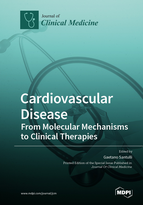Cardiovascular Disease: From Molecular Mechanisms to Clinical Therapies
A special issue of Journal of Clinical Medicine (ISSN 2077-0383). This special issue belongs to the section "Cardiovascular Medicine".
Deadline for manuscript submissions: closed (31 December 2020) | Viewed by 158313
Special Issue Editor
Interests: cardiology; hypertension; restenosis; heart failure; myocardial infarction; endothelial dysfunction; mitochondria; diabetes; microRNAs; insulin resistance; atherosclerosis; thrombosis; cardiac hypertrophy; pancreatic beta cell function; insulin release
Special Issues, Collections and Topics in MDPI journals
Special Issue Information
Dear Colleagues,
According to the most updated epidemiologic studies, cardiovascular disorders remain the leading cause of death. In fact, despite substantial advances in the care of patients, the incidence of cardiovascular disease continues to increase. Therefore, the search for novel mechanisms and therapeutics is desperately needed, and translational studies represent the best strategy to uncover novel therapeutic targets, reduce mortality, and improve the quality of life.
On these grounds, this Special Issue of Journal of Clinical Medicine has the main objective to gather papers that have both a strong basic research background and a clear translational potential. Therefore, studies exploring novel molecular mechanisms underlying cardiovascular diseases as well as pre-clinical and clinical investigations testing novel hypotheses that can advance the field are welcome in this Special Issue. The studies have to be well designed, with rigorous controls. Indeed, the ultimate, long-term goal of this Special Issue is to improve patient outcomes.
In this Special Issue, we are making a call to action to stimulate researchers as well as clinicians to submit their invaluable studies on cardiovascular disease. Original investigations, review articles, and short communications are especially welcome. Case reports will not be considered.
In summary, this Special Issue aims to underscore the key importance of basic cardiovascular research in the clinical scenario. Potential topics include, but are not limited to, the following:
- Atherosclerosis
- Hypertension
- Myocardial infarction
- Heart failure
- Cardiac Arrhythmias
- Metabolic Syndrome
- Stroke
- Pulmonary hypertension
- Peripheral Artery Disease (PAD)
- Acute Coronary Syndrome
- Myocarditis
- Pericarditis
- Valvulopathies
Dr. Gaetano Santulli
Guest Editor
Manuscript Submission Information
Manuscripts should be submitted online at www.mdpi.com by registering and logging in to this website. Once you are registered, click here to go to the submission form. Manuscripts can be submitted until the deadline. All submissions that pass pre-check are peer-reviewed. Accepted papers will be published continuously in the journal (as soon as accepted) and will be listed together on the special issue website. Research articles, review articles as well as short communications are invited. For planned papers, a title and short abstract (about 100 words) can be sent to the Editorial Office for announcement on this website.
Submitted manuscripts should not have been published previously, nor be under consideration for publication elsewhere (except conference proceedings papers). All manuscripts are thoroughly refereed through a single-blind peer-review process. A guide for authors and other relevant information for submission of manuscripts is available on the Instructions for Authors page. Journal of Clinical Medicine is an international peer-reviewed open access semimonthly journal published by MDPI.
Please visit the Instructions for Authors page before submitting a manuscript. The Article Processing Charge (APC) for publication in this open access journal is 2600 CHF (Swiss Francs). Submitted papers should be well formatted and use good English. Authors may use MDPI's English editing service prior to publication or during author revisions.
Keywords
- Atherosclerosis
- Hypertension
- Myocardial infarction
- Heart failure
- Cardiac Arrhythmias
- Metabolic Syndrome
- Stroke
- Pulmonary hypertension
- Peripheral Artery Disease (PAD)
- Acute Coronary Syndrome
- Myocarditis
- Pericarditis
- Valvulopathies







